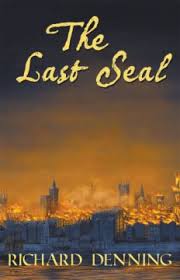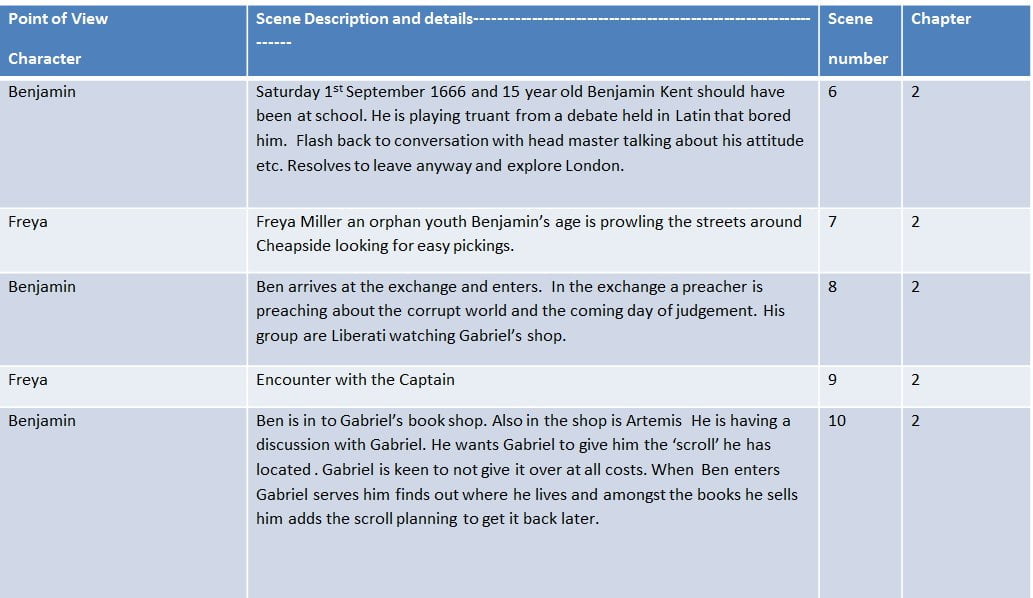British historical novelist Richard Denning explains the very popular Snowflake Method for planning and writing novels, illustrated by examples from one of his seven YA (young adult) novels, The Last Seal.
As a a self-published author of historical fiction and historical fantasy, I use the Snowflake Method to help me write novels. It was invented by Randy Ingermanson, the multiple-award-winning US novelist and teacher of writing crafts.
 Why Use the Snowflake Method?
Why Use the Snowflake Method?
The idea of the Snowflake Method is that, if it is done well, you can avoid major plot issues requiring major rewrites because you already have done that work. Furthermore you should spend less time staring at a blank page. You wrench the story idea out of your head at the start. Once you have built the snowflake it makes the writing easier. This does not mean you lose creativity. You have to be creative at the start as you make the snowflake. As you go along you often find new ideas pop up – indeed these can often be stimulated more because you already know the direction the novel is going and so your flakes of inspiration can link in better.
How To Use The Snowflake Method
I summarise the main steps here, using my YA historical novel The Last Seal as an example:
STEP 1 ONE SENTENCE SUMMARY
Write a one-sentence summary of your novel. This sentence could become the hook that will sell your book. A good sentence is shorter rather than longer – ideally fewer than 15 words. It should not contain character names. It is better to say “a mercenary time travelling adventurer” than “Septimus Mason”. This sentence should aim to tie together the big picture of the book with the personal picture of the main character. We should learn which character has the most to lose in this story and what he or she wants to gain. Here's a one sentence summary of my YA novel, The Last Seal:
“London 1666: a schoolboy and a thief brave the perils of the Great Fire to prevent an even more terrible catastrophe!”
STEP 2 ONE PARAGRAPH PLOT
You now need to expand that sentence to a full paragraph describing the background, the major disasters, and the ending of the novel.
It is a good idea to think about the a story as “three disasters plus an ending”. Each of the disasters takes a quarter of the book to develop and the ending takes the final quarter. If you are approaching publishers you can also use this paragraph in your proposal. Or alternatively if you self-publish this could easily become the back cover blurb. Ideally, your paragraph will have about five sentences: one sentence to give me the backdrop and story setup, one sentence each for your three disasters, then one more sentence to tell the ending. Here's my one-paragraph plot for The Last Seal:
“In September 1666 a schoolboy playing truant and a local thief blunder into a struggle between rival secret societies. They discover that the Liberati serve a powerful demon which was locked under London by their opponents the Praesidum who created magical seals round the city which now the Liberati aim to destroy when they start the fire at Pudding Lane. As the fire spreads, the two youths and the Praesidum must evade the deadly Liberati as they try to locate the remaining seals. They discover that the location of the final seal is given on a secret key hidden somewhere in the city. A desperate race ensues to find the key, locate the final seal and prevent the demon being freed.”
STEP 3 DEVELOP CHARACTERS
 Plots are all very good but the book is going to need compelling characters. So you need something similar for the storylines of each of your characters. For each of your major characters, we need this information:
Plots are all very good but the book is going to need compelling characters. So you need something similar for the storylines of each of your characters. For each of your major characters, we need this information:
- The character's name
- A one-sentence summary of the character's storyline
- The character's goal (what does he/she want?)
- The character's conflict (what prevents him/her from reaching this goal?)
- The character's epiphany (what will he/she learn, how will he/she change? A one-paragraph summary of the character's storyline
I developed this profile for my character Freya in The Last Seal:
- Summary: Cheerful , cheeky but , selfish young thief finds a purpose through perilous adventure.
- Goal: To survive each day and get as much as she can. To gain wealth, avoid responsibility
- Obstacles: Uneducated, orphan gutter snipe with no prospects
- Epiphany: There are things more important than self, higher purposes which are worth risking self for
- Synopsis of character story line: Freya scrapes a living thieving and pick-pocketing. One day she is caught red handed and shifts the blame on Benjamin a school boy playing truant who runs with her to escape capture right into an encounter with agents of the Liberati who threaten them both. Escaping with Ben they encountering the Praesidum. Initially she refuses to help the Praesidum unless she gains a reward but gradually comes to realise that the Liberati must be opposed and in so doing her shallow existence gains meaning. Helps reforms the Praesidum at the end and resolves to continue its mission.
STEP 4 PLOT SUMMARY
The snow flake grows. You now expand the one paragraph summary of the plot. Each sentence expands into a full paragraph. All but the last paragraph should end in a disaster. The final paragraph should tell how the book ends. So you now have maybe a full sheet with your plot on.
STEP 5 CHARACTER CHARTS
Take your character synopsis and now expand your character descriptions into full-fledged character charts. Detail everything there is to know about each character, such as birthdate, description, history, motivation, goals, etc.
STEP 6 EXPAND THE PLOT SYNOPSIS
By now, you have a solid story and several story-threads, one for each character. Now expand the one-page plot synopsis of the novel to a four-page synopsis. Basically, you will again be expanding each paragraph from step (4) into a full page. Take that four-page synopsis and make a list of all the scenes that you'll need to turn the story into a novel. Make a list of each scene throughout the whole books and organise them into chapters. Here's how I did it for The Last Seal:
At this point I open up Word and slap in all those scenes. Then I just sit down and start pounding out the real first draft of the novel. If I follow this process well (and I confess I don’t always manage to be quite so elaborate), I am often astounded at how fast the story flies out of my fingers at this stage.
- I KNOW the story
- I KNOW the characters
- I KNOW the scenes
- I can just get writing!
Seat of pants writers may not like this approach but I find I need the framework to get me started.
Randy Ingermanson offers more information about his Snowflake Method and much more writing advice at his excellent website, www.advancedfictionwriting. com.







[…] a detailed explanation on the Snowflake Technique, you can read more in this blog post: https://selfpublishingadvice.org/writing-how-to-use-the-snowflake-technique-to-write-a-novel/. I will provide a summary so you can determine if it might suit […]
[…] Writing: How To Use the Snowflake Technique to Write A Novel […]
[…] Writing: How To Use the Snowflake Technique to Write A Novel […]
This helps a lot when writing. I used it for a story I’m creating for my students and they loved it. A couple suggested publishing it, which I plan on getting done at some point. I love the examples and everything- a great way for gradually getting stuff done.
[…] Writing: How To Use the Snowflake Technique to Write A Novel […]
[…] (summarized from: How to Plan and Write Novels Using the Snowflake Method) […]
[…] the Snowflake Method is quite useful. As Richard Denning, author and writer of “Writing: How To Use the Snowflake Technique to Write A Novel” […]
Thanks for this article. I’ve attended one of Randy’s workshops about the snowflake method and the creativity and structure to the process appeals to me, particularly as I’m facing a second major re-write due to a plot that just doesn’t work. You’ve reminded me that this could be the plotting/characterisation method that works for me. Worth a go, that’s for sure.
Thank you for the advice! This is a little more structured than I like to be at the very beginning, but you offered up some crucial tips about what to think about, what to look for, and to create a plot and characters which will keep moving forward. Excellent article!
Here is an article I wrote. It’s about how I used the Snowflake Technique to write an original screenplay called: Condemn Nation (https://jessegreathouse.com/portfolio/condemn-nation-original-screenplay/). I thought people would find it an interesting read on how I put this theory into practice, and why.
[…] https://selfpublishingadvice.org/writing-how-to-use-the-snowflake-technique-to-write-a-novel/ […]
[…] the Snowflake Method is quite useful. As Richard Denning, author and writer of “Writing: How To Use the Snowflake Technique to Write A Novel” […]
[…] How to Use the Snowflake Technique to Write a Novel – by Richard Denning […]
[…] d’actes. Pour ce roman-ci, j’utiliserai plutôt la méthode snowflakes adapté. (voir https://selfpublishingadvice.org/writing-how-to-use-the-snowflake-technique-to-write-a-novel/) qui est en fait une méthode d’écriture qui consiste à étoffer le sysnopsis en novella […]
Thank you, I’m just about to embark on writing my first novel, after years of deliberating over whether I’m capable of doing this, with any measure of success. I like the steps you use and will aim to utilise this structure to help with my novel outline. Thank you for making the snowflake method simple to follow.
just started reading about the Snowflake Method and wanted an example for step 3. Helped me out alot! I also thought my first sentence from step one was very bland and not very descriptive, but I guess you can’t really tell much in only one sentence. Thank you!
[…] a couple techniques writers can use when drafting their novel. Self Publishing Advice advocates for The Snowflake Technique, which can help you avoid plot issues by following six steps. Steps include writing a summary, […]
I bought the Snowflake program on my old PC and used it to make a storyline. I never wrote that story as planned, but Snowflake certainly helped me to make the plot and characters clear in my head.
Still, the story doesn’t end there – I bought a Mac, but did not buy the Mac version of the Snowflake (yet). The story line I created with Snowflake for was used as basis of the novel I have now written – I just took another angle to the story.
My writing style is such that the characters seem to surprise me by doing unplanned things and the story goes to quite another direction than my original intention was, but I think the Snowflake is still good to use. You can tweak your story line later, if necessary, or create a completely new one. For writers whose writing seems to be all over the place, the method can give a nice framework and maybe some discipline to write.
Leena, the thing that you planned something does not mean that you have to stick to it or leave it.
If a new idea comes up to your mind while you’re writing (after you’ve planned everything), you can refactor (edit) your plot synopsis and list of scenes. It’s not a crime. ; )
It’s just a “redisign”. ; )
[…] synopsis first and using a technique commonly known as ‘snowflaking’ or the ‘snowflake method‘ to expand it out. This has the benefit of you being able to keep sections of the work in […]
[…] novelist and inventor of the hugely popular “snowflake method” of writing, which was highlighted on this blog a couple of weeks ago by ALLi author Richard […]
[…] The snowflake method for planning your blog content. […]
Thank you Richard, you put a lot of sense to the Snowflake method and I intend to plot and design my novel in this way. I want to add that scrivener eases the snowflake method more than a word software.
Cheers
[…] Planning a novel Using The Snowflake Technique […]
These days is a ideal day to capitalize on getting
solutions to this sort of query. There was great loss when
1 passed, the other pined and endured greatly within. Are they performing
issues for the right factors?
[…] award winning novelist and inventor of the hugely popular "snowflake method" of writing, which was highlighted on this blog a couple of weeks ago by ALLi author Richard […]
[…] snowflake method sounds like an interesting approach. If you have tried it I’d be interested to know what you […]
Hi Richard:
Glad to see you like my Snowflake method! When I first posted the Snowflake article on my web site, I had no idea it would become so popular all around the world. I thought a few people might find it interesting.
In my opinion, there is no one best way to get your first draft written. The Snowflake method is one “creative paradigm” but there are plenty of others, such as the Seat of the Pants method, the Edit As You Go method, and the outliner method. Whatever works for you is what works for you.
The value of talking about creative paradigms is that when you see how other writers do it, you sometimes realize that you have other options. People email me all the time to say that the Snowflake has liberated them–they thought a writer was supposed to just write to a blank page with no preparation. Of course, other writers would feel like the Snowflake is a pair of handcuffs on their creativity–they really need that blank page.
To each his own.
I was interested in the article as I’d seen this idea elsewhere… I use a similar method and find it really suits me… though as you say, there are other ways. Where I found it was in a women’s writing mag, and to kick off you write a 50-word sentence, I think, then you do a synopsis in 10 50-word points, expand to 500-words etc… all based on the expanding synopsis … similar but not the same. What is so good about these methods is that the whole is made up of parts, so the parts (if you want to) can continue to be worked on as sections/parts and the whole doesn’t look such an enormous enterprise!
Thanks for article.
Excellent and useful post – I too use something similar, although not as well regimented as you, Richard. I was also surprised to find that you use Word for the writing bit – have you tried Scrivener? I don’t use it myself but having looked at the software, would think it’d be perfect for this kind of approach to writing?
I’ve often heard of the Snowflake method, but I’ve never actually seen it in action like you do here, Richard. Nice work. I think that this is a great starting point for any novel.
I’ve used this – but I didn’t know it by any name at all… keeping head well down, I suspect I half thought it up myself and half adapted it from a book on writing…or from something in Mslexia magazine. It can work well: though not so easy when you are doing a follow-up (as I am) and have your characters already there – only their younger selves. On the up side, I had a good idea what was going to happen event-wise. On the down side, it’s still involved re-writes (am doing those now) as turned out not tight enough – BUT that may’ve been because I did allow/find necessary a few areas needed expanding to clarify plot.
Anyhow, many thanks for posting: shall try to use the method again, with more precision next time!
A fabulous post. Thank you Richard. What a wonderful method too. I write for children with no more than 40pages usually. But I love a challenge! Will therefore be looking into writing my first, proper, novel – looking foward to reading The Last Seal by the way. Caz
Thanks guys. Jessica although it might sound very planned there are still many gaps you need to fill. I often find i am writing a bit and suddenly inspiration hits about how a twist to what I planned could link in better. Usually I don’t quite plan the very end either. I like that to come as a surprise. But I find if I don’t have an outline it is hard to even get started in he first place.
What an excellent post! Thank you. I enjoy using the Snowflake method as well. My most recent use was in preparation for NaNoWriMo 2013. As a result, I completed 50000 words with over a week to spare.
Interesting! Sounds like this really works for you and that’s fabulous. It’s always fantastic when you discover the groove that keeps you writing. Unfortunately for me, if I planned so much detail before writing, I’d already be bored of my story. The “not-knowing” is what keeps me motivated. I sorta envy those who are comfortable planning so much. It would probably make my writing life a lot easier.
Thanks for a really interesting post, Richard. I’d never heard of the Snowflake Method before, but this sounds a very useful approach, especially for new novelists. I’d always been daunted by the thought of writing a novel before – I specialise in short fiction and non-fiction – but you’re making me seriously consider the possibility now. Thank you!